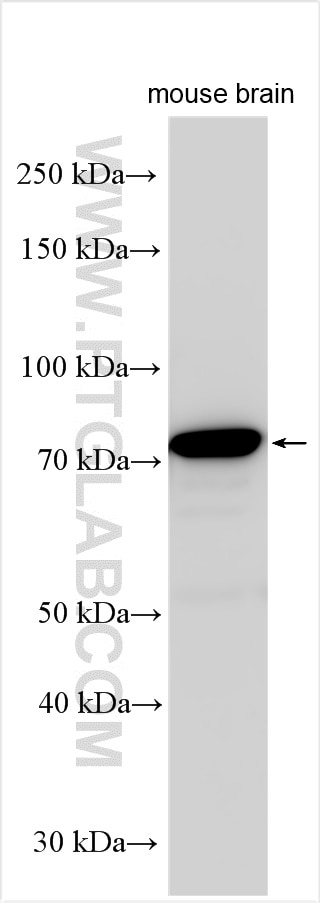PLTP Polyklonaler Antikörper
PLTP Polyklonal Antikörper für WB, ELISA
Wirt / Isotyp
Kaninchen / IgG
Getestete Reaktivität
human, Maus
Anwendung
WB, ELISA
Konjugation
Unkonjugiert
Kat-Nr. : 15635-1-AP
Synonyme
Geprüfte Anwendungen
| Erfolgreiche Detektion in WB | Maushirngewebe |
Empfohlene Verdünnung
| Anwendung | Verdünnung |
|---|---|
| Western Blot (WB) | WB : 1:500-1:3000 |
| It is recommended that this reagent should be titrated in each testing system to obtain optimal results. | |
| Sample-dependent, check data in validation data gallery | |
Produktinformation
15635-1-AP bindet in WB, ELISA PLTP und zeigt Reaktivität mit human, Maus
| Getestete Reaktivität | human, Maus |
| Wirt / Isotyp | Kaninchen / IgG |
| Klonalität | Polyklonal |
| Typ | Antikörper |
| Immunogen | PLTP fusion protein Ag8096 |
| Vollständiger Name | phospholipid transfer protein |
| Berechnetes Molekulargewicht | 493 aa, 55 kDa |
| Beobachtetes Molekulargewicht | 73 kDa |
| GenBank-Zugangsnummer | BC005045 |
| Gene symbol | PLTP |
| Gene ID (NCBI) | 5360 |
| Konjugation | Unkonjugiert |
| Form | Liquid |
| Reinigungsmethode | Antigen-Affinitätsreinigung |
| Lagerungspuffer | PBS with 0.02% sodium azide and 50% glycerol |
| Lagerungsbedingungen | Bei -20°C lagern. Nach dem Versand ein Jahr lang stabil Aliquotieren ist bei -20oC Lagerung nicht notwendig. 20ul Größen enthalten 0,1% BSA. |
Hintergrundinformationen
PLTP (phospholipid transfer protein) belongs to the family of lipid-binding and lipid-transfer proteins. PLTP is involved in the distribution and metabolism of high-density lipoprotein ( HDL ) and reverse cholesterol transfer ( RCT ). In plasma, PLTP catalyzes the transfer of phospholipids ( mainly phosphatidylcholine ) between lipoproteins (PMID: 29558025). PLTP has a predicted protein molecular mass of approximately 55 kDa, and molecular weights of 70-80 kDa can also be detected in some literature (PMID: 26160914; 36312255; 29680823; 15342679; 7654777).
Protokolle
| PRODUKTSPEZIFISCHE PROTOKOLLE | |
|---|---|
| WB protocol for PLTP antibody 15635-1-AP | Protokoll herunterladen |
| STANDARD-PROTOKOLLE | |
|---|---|
| Klicken Sie hier, um unsere Standardprotokolle anzuzeigen |


